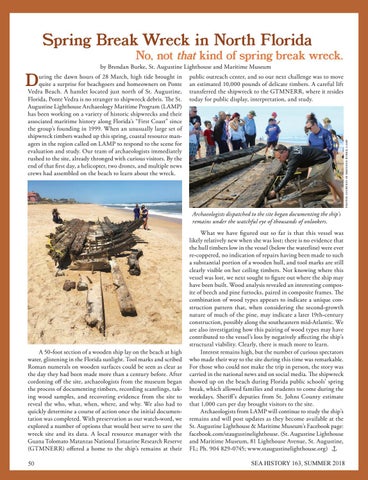Spring Break Wreck in North Florida
by Brendan Burke, St. Augustine Lighthouse and Maritime Museum
uring the dawn hours of 28 March, high tide brought in quite a surprise for beachgoers and homeowners on Ponte Vedra Beach. A hamlet located just north of St. Augustine, Florida, Ponte Vedra is no stranger to shipwreck debris. The St. Augustine Lighthouse Archaeology Maritime Program (LAMP) has been working on a variety of historic shipwrecks and their associated maritime history along Florida’s “First Coast” since the group’s founding in 1999. When an unusually large set of shipwreck timbers washed up this spring, coastal resource managers in the region called on LAMP to respond to the scene for evaluation and study. Our team of archaeologists immediately rushed to the site, already thronged with curious visitors. By the end of that first day, a helicopter, two drones, and multiple news crews had assembled on the beach to learn about the wreck.
public outreach center, and so our next challenge was to move an estimated 10,000 pounds of delicate timbers. A careful lift transferred the shipwreck to the GTMNERR, where it resides today for public display, interpretation, and study.
photos courtesy of brendan burke, lamp
D
No, not that kind of spring break wreck.
Archaeologists dispatched to the site began documenting the ship’s remains under the watchful eye of thousands of onlookers.
A 50-foot section of a wooden ship lay on the beach at high water, glistening in the Florida sunlight. Tool marks and scribed Roman numerals on wooden surfaces could be seen as clear as the day they had been made more than a century before. After cordoning off the site, archaeologists from the museum began the process of documenting timbers, recording scantlings, taking wood samples, and recovering evidence from the site to reveal the who, what, when, where, and why. We also had to quickly determine a course of action once the initial documentation was completed. With preservation as our watch-word, we explored a number of options that would best serve to save the wreck site and its data. A local resource manager with the Guana Tolomato Matanzas National Estuarine Research Reserve (GTMNERR) offered a home to the ship’s remains at their 50
What we have figured out so far is that this vessel was likely relatively new when she was lost; there is no evidence that the hull timbers low in the vessel (below the waterline) were ever re-coppered, no indication of repairs having been made to such a substantial portion of a wooden hull, and tool marks are still clearly visible on her ceiling timbers. Not knowing where this vessel was lost, we next sought to figure out where the ship may have been built. Wood analysis revealed an interesting composite of beech and pine futtocks, paired in composite frames. The combination of wood types appears to indicate a unique construction pattern that, when considering the second-growth nature of much of the pine, may indicate a later 19th-century construction, possibly along the southeastern mid-Atlantic. We are also investigating how this pairing of wood types may have contributed to the vessel’s loss by negatively affecting the ship’s structural viability. Clearly, there is much more to learn. Interest remains high, but the number of curious spectators who made their way to the site during this time was remarkable. For those who could not make the trip in person, the story was carried in the national news and on social media. The shipwreck showed up on the beach during Florida public schools’ spring break, which allowed families and students to come during the weekdays. Sheriff’s deputies from St. Johns County estimate that 1,000 cars per day brought visitors to the site. Archaeologists from LAMP will continue to study the ship’s remains and will post updates as they become available at the St. Augustine Lighthouse & Maritime Museum’s Facebook page: facebook.com/staugustinelighthouse. (St. Augustine Lighthouse and Maritime Museum, 81 Lighthouse Avenue, St. Augustine, FL; Ph. 904 829-0745; www.staugustinelighthouse.org) SEA HISTORY 163, SUMMER 2018
